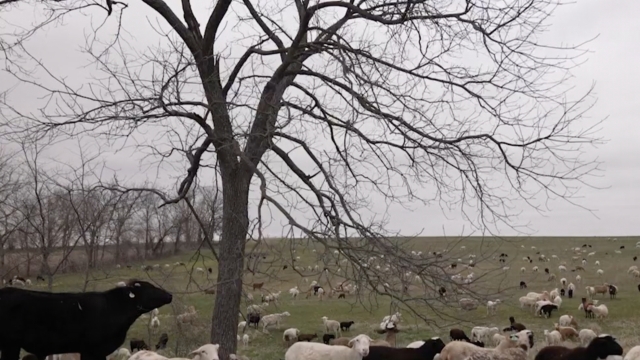There's no surrounding ocean nor sounds of the shore. But for a farmer, a farm can often feel like an island.
"The loneliness of the 'weird farmer' is a real thing," said Josh Payne, who runs his family farm, Payne Farms, with his sister. Their farm is a little different than that of their neighbors.
"We as farmers like big, manageable, easy-to-manage spaces that we can run a tractor through," Payne said. "And trees kind of get in the way of some of that stuff."
On Payne's 300 acres are the seeds of what will become 10,000 trees. There are also sheep: 800 ewes and 1,000 lambs grazing on grass. It's part of a method of farming called silvopasture. Payne and others see it as a solution for sustainable, climate-friendly farming.
"Silvopasture is not new," said Ashley Conway-Anderson, who teaches at the University of Missouri's Center for Agroforestry.
Silvopasture refers to intentionally integrating livestock with forages and trees. It creates an ecosystem vastly different from the rows and rows of typical farms.
"I think it's our responsibility, being in the position that we're in, to be as responsible as we can with the land that we have," Conway- Anderson said. "It still provides a lot of really high-nutrient density food. It manages landscape in a more ecologically friendly way. But it is productive."
It's also built for more extreme weather. On this day on Payne Farms, it's 35 degrees with 30-mph winds. The sheep use the trees as a windbreak. In the increasing and intensifying heat of summer, they'll use the trees for shade.
It's among the reasons, Payne says, silvopasture protects farms against the two words often not spoken on farms.
"If you mention 'climate change,'" Payne said, "it stops the conversation."
Fewer than 2% of American farms report using agroforestry of any kind, let alone silvopasture. Payne got into it when he took over the family farm and realized he's allergic to herbicides. Now he's making a long-term investment in trees that won't mature for a decade.
"If I go talk about my herbicide issue in Kansas City and I'll say, 'Well, I'm allergic to herbicides,' everybody says, 'Well, everybody is,'" Payne said. "But if you come out here, it's a threat to people's existence because that's how we maintain our fields."
Payne sees the value in being an island, but he hopes he won't be for long.
Over the next five years, The Nature Conservancy will award tens of millions of USDA dollars to help tens of thousands of farmers attempt agroforestry.
Payne says his island is proof that mixing livestock and trees is better for the land, the animals, the climate — and his bottom line.
"We couldn't make the choice to lose a bunch of money all the time so that we can just do what we feel, to do what we think is best for the world," Payne said. "Then we'd have to sell out to somebody else, and somebody else would be doing something that we don't believe in anyway. Our farm is a really great testament to slow progress."
SEE MORE: Black farmers say debt relief program is too little, too late
Trending stories at Scrippsnews.com





